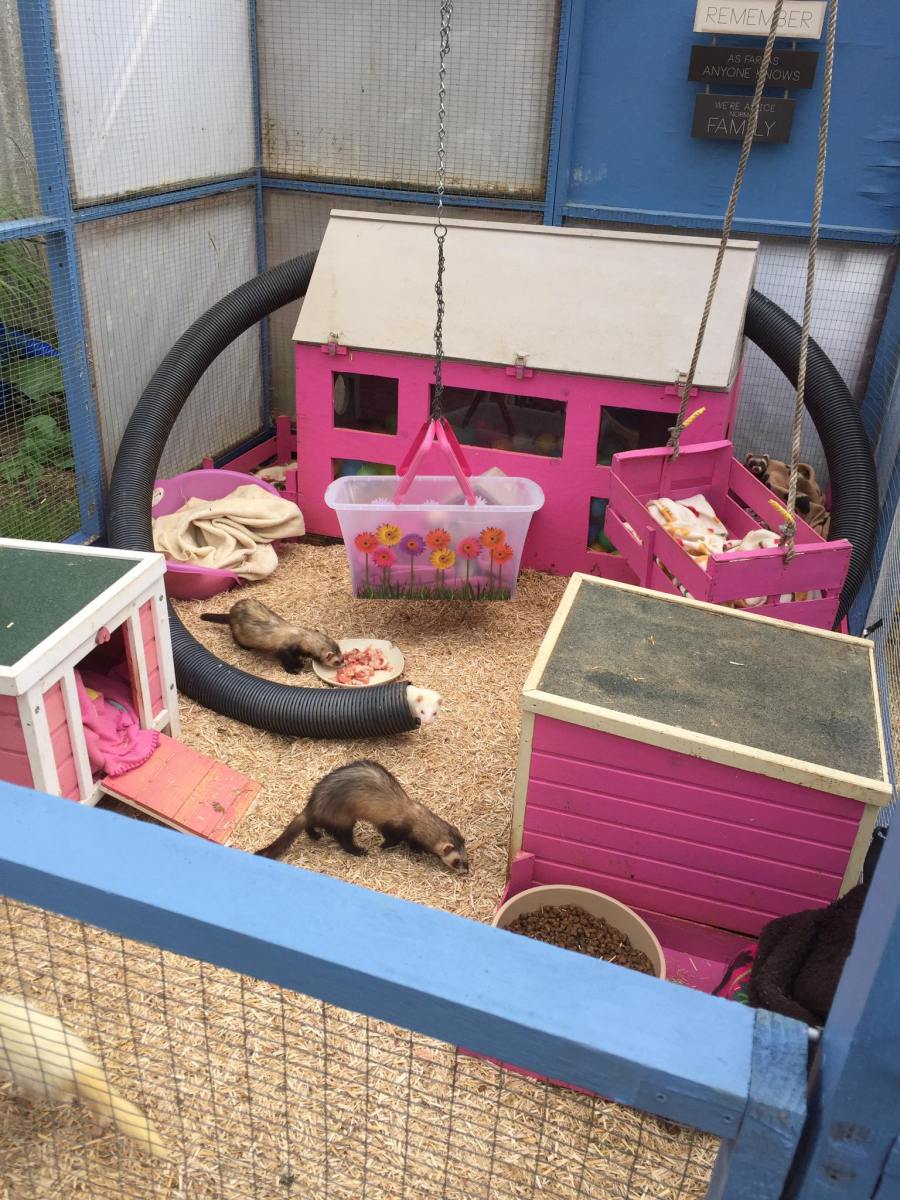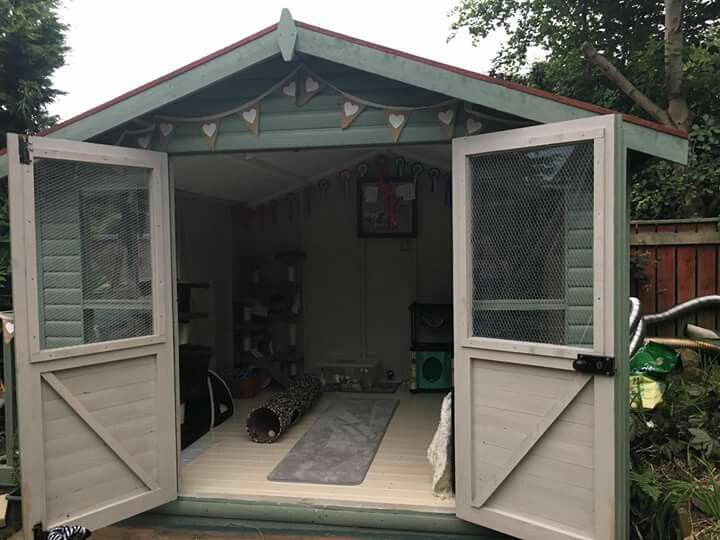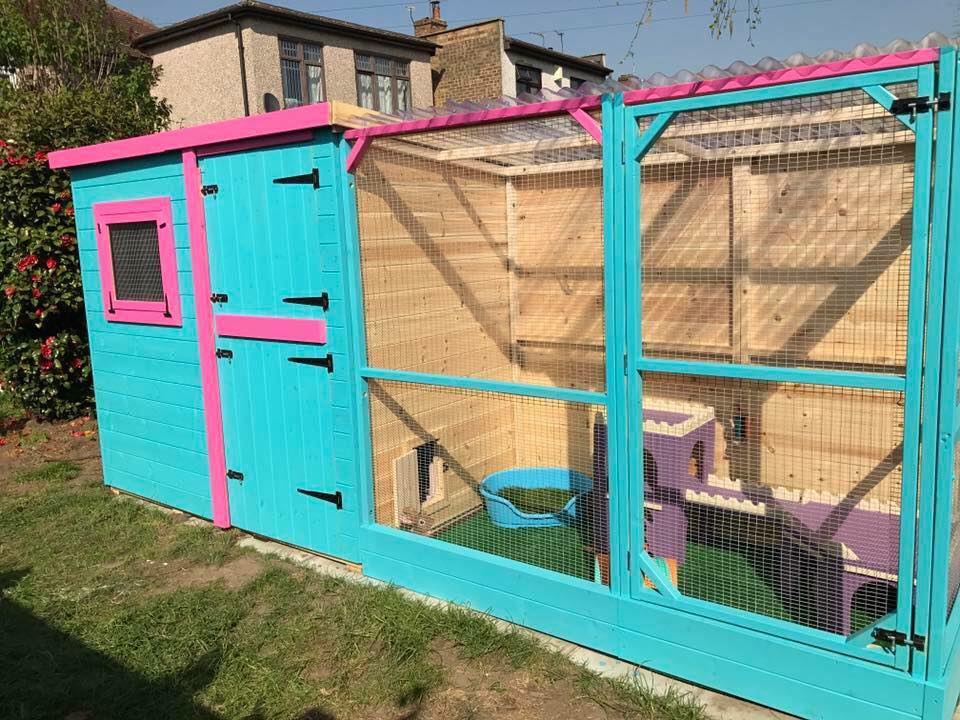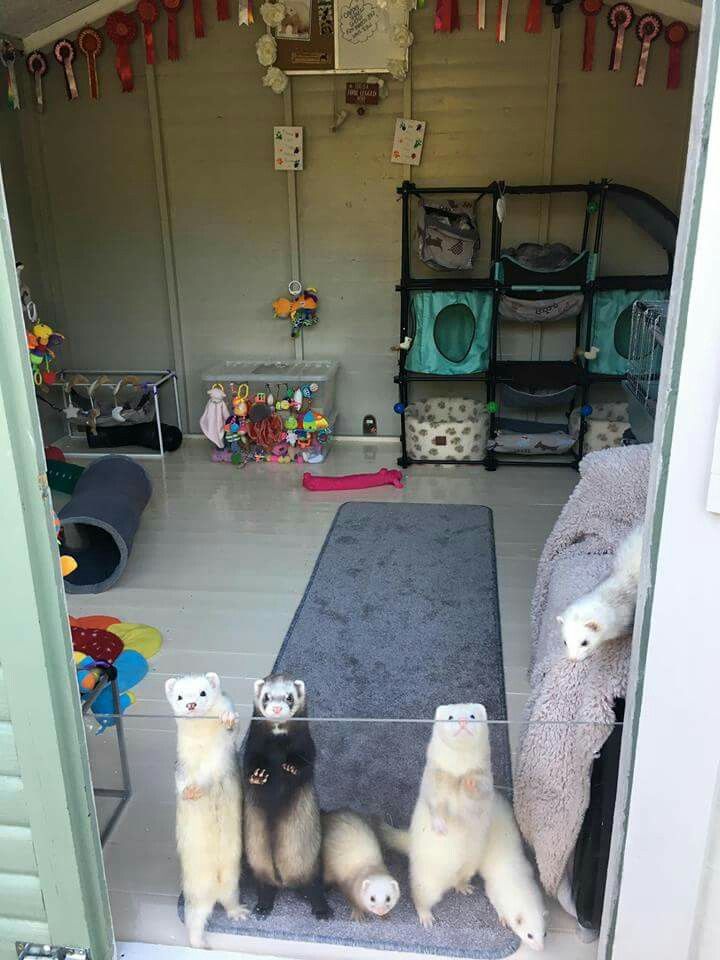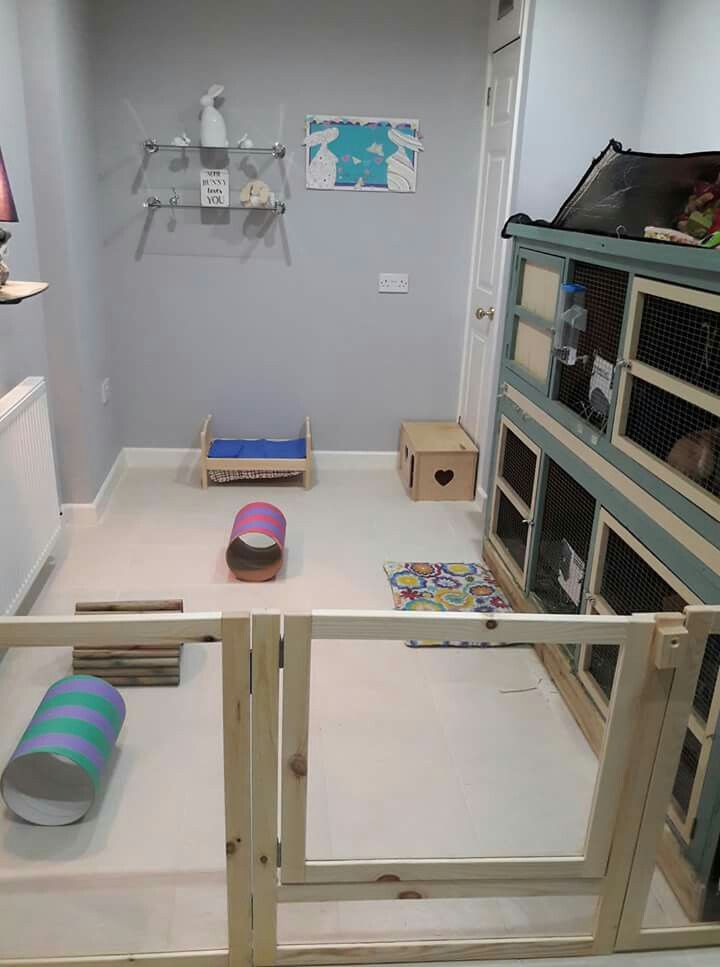General Information:
Ferrets belong to the family Mustelidae and are in the same genus as weasels; Mustela. They're an inquisitive, intelligent, and mischievous carnivore who can form incredibly strong bonds with their humans. Previously, they've been used for hunting animals such as rabbits, but they're becoming increasingly popular pets.
They're a crepuscular mustelid who can sleep up to 20 hours a day! Though, they do make up for it when they're awake; ferrets are notoriously cheeky and require lots of space and free-roam time.
Fun fact:
A group of ferrets is called a business. Ferrets are gregarious and usually live socially, but occasionally a ferret will prefer to live alone.
Care:
Housing/Enrichment:
Ferrets can live either indoors or outdoors, however, we we personally believe living outdoors is the better option for ferrets. They can be exposed to natural light cycles and seasonal changes. If housing indoors, an ourdoor play area would still be ideal.
Please take care when housing near prey species, it's advised to keep them in a separate room because the ferrets natural odour will induce stress in prey species.
Ferrets are known for their "slinky" and flexible snake-like bodies that makes them infamous escape artists.
Ensure their living environment is between 15-24°c as heatstroke is a common issue given their inability to sweat. Ferrets can adapt to colder temperatures such as 7-10°c. Humidity should be approximately 40-65%.
Outdoors:
There is no specific housing sizes recommended for ferrets. With there being no universal requirements, this is often left up to interpretation. Basic requirements include the ability to exhibit natural behaviours and move around freely. As mentioned, ferrets are infamous escape artists so the enclosure must be sturdy. Shed conversions, ideally with insulation and metal framing, make a great option. Ensure any mesh used on part of the enclosure is fox proof as ferrets are still preyed upon. Protection from the elements is a must.
In our opinion, a hutch is not a suitable long term enclosure.
Useful Links:
Ferrets belong to the family Mustelidae and are in the same genus as weasels; Mustela. They're an inquisitive, intelligent, and mischievous carnivore who can form incredibly strong bonds with their humans. Previously, they've been used for hunting animals such as rabbits, but they're becoming increasingly popular pets.
They're a crepuscular mustelid who can sleep up to 20 hours a day! Though, they do make up for it when they're awake; ferrets are notoriously cheeky and require lots of space and free-roam time.
Fun fact:
A group of ferrets is called a business. Ferrets are gregarious and usually live socially, but occasionally a ferret will prefer to live alone.
Care:
Housing/Enrichment:
Ferrets can live either indoors or outdoors, however, we we personally believe living outdoors is the better option for ferrets. They can be exposed to natural light cycles and seasonal changes. If housing indoors, an ourdoor play area would still be ideal.
Please take care when housing near prey species, it's advised to keep them in a separate room because the ferrets natural odour will induce stress in prey species.
Ferrets are known for their "slinky" and flexible snake-like bodies that makes them infamous escape artists.
Ensure their living environment is between 15-24°c as heatstroke is a common issue given their inability to sweat. Ferrets can adapt to colder temperatures such as 7-10°c. Humidity should be approximately 40-65%.
Outdoors:
There is no specific housing sizes recommended for ferrets. With there being no universal requirements, this is often left up to interpretation. Basic requirements include the ability to exhibit natural behaviours and move around freely. As mentioned, ferrets are infamous escape artists so the enclosure must be sturdy. Shed conversions, ideally with insulation and metal framing, make a great option. Ensure any mesh used on part of the enclosure is fox proof as ferrets are still preyed upon. Protection from the elements is a must.
In our opinion, a hutch is not a suitable long term enclosure.
Useful Links:
Indoors:
Ferrets require a large amount of space. It's generally advised to house them within a large (usually a multi-story) metal cage and convert a room, or space within your home and 'ferret-proof' the area. This is done by ensuring your ferret can't injure themselves or damage your home - some damage will be unavoidable, this comes with the territory of keeping ferrets.
Ferrets will usually utilise most toys due to their inquisitive nature. Favourable toys include tubes, hammocks, beds, digging boxes, treat puzzles, cat towers, shallow water, ball pits and other toys that will appeal to their natural behaviours. Remember, ferrets enjoy digging, playing, foraging, hiding, and resting.
Litter Training:
Both indoor and outdoor ferrets can be litter trained as ferrets usually go to the bathroom in one or two locations. Ferret litter trays have high-backs and usually fit into a corner; ferrets prefer to eliminate on vertical surfaces. When eliminating, a ferret will often back into a corner, and squirt upwards.
Ferrets require a large amount of space. It's generally advised to house them within a large (usually a multi-story) metal cage and convert a room, or space within your home and 'ferret-proof' the area. This is done by ensuring your ferret can't injure themselves or damage your home - some damage will be unavoidable, this comes with the territory of keeping ferrets.
Ferrets will usually utilise most toys due to their inquisitive nature. Favourable toys include tubes, hammocks, beds, digging boxes, treat puzzles, cat towers, shallow water, ball pits and other toys that will appeal to their natural behaviours. Remember, ferrets enjoy digging, playing, foraging, hiding, and resting.
Litter Training:
Both indoor and outdoor ferrets can be litter trained as ferrets usually go to the bathroom in one or two locations. Ferret litter trays have high-backs and usually fit into a corner; ferrets prefer to eliminate on vertical surfaces. When eliminating, a ferret will often back into a corner, and squirt upwards.
Diet:
The ferret is a strict/obligate carnivore which is easy to tell by their dentition, their short gastrointestinal tract, and lack of a caecum and ileocolic valve. They have a high metabolic rate so they need to eat little and often which is seen in many Mustelids. Many owners feed ad libitum. The average ferret is expected to eat approximately 5-7% of their bodyweight daily. It is recommended to have food available for them at all times. It is advised that ferrets have a high animal protein diet ranging from 35-40%, animal fat varying from 9-28%, carbohydrates <25%, and fibre <2.5%. Pelleted diets are recommended to be part of their daily diet at the very least as they’ve been documented to reduce the amount of dental calculus formed. You can find some premium kitten and cat pellets suitable for ferrets, as well as those marketed for ferrets. Feeding dog food is discouraged as dogs are able to process carbohydrates far more effectively than a ferret. Raw meat diets have become increasingly popular, this has been referred to as BARF diet by the British Ferret Club. Clean sources of a whole prey/animal meat diet are now more widely available partially thanks to the reptile market. Many breeders and experienced keepers suggest a diet of 80% muscle meat, 10% secreting organs such as liver and kidney, and 10% bone which are loosely based off a whole prey model (some models have slightly different percentages). There are various available online diet plans which can help achieve this; from offering whole prey, specific body parts of a prey animal, or minced foods. Some raw food diets in particular may require additional supplementation. It is advised you feed more red meat than white (unless there is an underlying medical condition that states feeding otherwise), and avoid pork. It is important that any meat provided is not of low-quality and containing too much indigestible protein such as fur, hooves, and too many bones, or too little muscle meat. Storing and handling of raw meat must also be done carefully, effectively, and hygienically to avoid contamination in both owner and ferret.
Ferrets may often become imprinted on a certain food type and be reluctant to eat any other foods offered. It is advised that a new owner is aware of what their new ferret is used to eating, and if changes need to be made then this should be done very gradually over a period of time.
There are a few dietary options available for ferrets: Avoid feeding fruits, vegetables, and lactose.
Useful Links:
Socialising:
Sex terms:
Hob: Male
Jill: Female
Gib: Neutered male
Sprite: Neutered female
Ferrets are social and sexually dimorphic mustelids; males are substantially larger than females. They make a variety of social sounds from chuckling to hissing.
Jills are known as induced ovulators. Without the sexual activity from a male, a jill can actually die. For this reason, socialising and ferrets is something you must be familiar with.
Hobs: Hobs usually live well together but can be driven by a mating instinct during breeding seasons. Hobs are known for their pungent odour which cannot be reduced without neutering. Personally, we wouldn't neuter purely for odour reduction.
Gibs: A gib will usually have a far less pungent odour and, depending on the way they've been neutered, will have less of a mating instinct. They can live with either males or females.
Sprites: Sprites live well with both males and females.
If socialised from a young age, ferrets see humans as companions and form very strong bonds with their owners.
Health:
Similarly to cats and dogs, ferrets can also catch distemper. There isn't a vaccination available in the UK licensed for ferrets, but yearly vaccinations with an off-license vaccine is the best way to protect your ferret from CDV.
What is CDV (canine distemper virus)?
Canine distemper is a fast-acting, often deadly, and a very contagious virus belonging to a class of viruses known as Morbillivirus; it's relative to measles.
CDV can affect the respiratory tract, gastrointestinal tract, and central nervous system of the infected individual. The disease can be transmitted via direct contact with an infected animal and can spread through the air through becoming airborne.
Symptoms include:
The prognosis for CDV is very poor, and most diagnoses are made post-mortem. Treatment is extensive and oftentimes expensive. Your ferret will be admitted as an inpatient, and quarantined away from other animals. Fluids, antiviral agents, antibiotics and immunosuppressants are ordinarily used to treat CDV.
In canines, more than 50% of dogs will die within 2-12 weeks after treatment. Early treatment will promote a higher chance of recovery, but a full recovery isn't guaranteed.
Prevention Methods:
In the UK, de-scenting ferrets (removing anal glands) is not allowed as it is considered an unnecessary mutation.
Please feel free to ask more questions.
The ferret is a strict/obligate carnivore which is easy to tell by their dentition, their short gastrointestinal tract, and lack of a caecum and ileocolic valve. They have a high metabolic rate so they need to eat little and often which is seen in many Mustelids. Many owners feed ad libitum. The average ferret is expected to eat approximately 5-7% of their bodyweight daily. It is recommended to have food available for them at all times. It is advised that ferrets have a high animal protein diet ranging from 35-40%, animal fat varying from 9-28%, carbohydrates <25%, and fibre <2.5%. Pelleted diets are recommended to be part of their daily diet at the very least as they’ve been documented to reduce the amount of dental calculus formed. You can find some premium kitten and cat pellets suitable for ferrets, as well as those marketed for ferrets. Feeding dog food is discouraged as dogs are able to process carbohydrates far more effectively than a ferret. Raw meat diets have become increasingly popular, this has been referred to as BARF diet by the British Ferret Club. Clean sources of a whole prey/animal meat diet are now more widely available partially thanks to the reptile market. Many breeders and experienced keepers suggest a diet of 80% muscle meat, 10% secreting organs such as liver and kidney, and 10% bone which are loosely based off a whole prey model (some models have slightly different percentages). There are various available online diet plans which can help achieve this; from offering whole prey, specific body parts of a prey animal, or minced foods. Some raw food diets in particular may require additional supplementation. It is advised you feed more red meat than white (unless there is an underlying medical condition that states feeding otherwise), and avoid pork. It is important that any meat provided is not of low-quality and containing too much indigestible protein such as fur, hooves, and too many bones, or too little muscle meat. Storing and handling of raw meat must also be done carefully, effectively, and hygienically to avoid contamination in both owner and ferret.
Ferrets may often become imprinted on a certain food type and be reluctant to eat any other foods offered. It is advised that a new owner is aware of what their new ferret is used to eating, and if changes need to be made then this should be done very gradually over a period of time.
There are a few dietary options available for ferrets: Avoid feeding fruits, vegetables, and lactose.
Useful Links:
- www.pfma.org.uk/ferrets-nutritional-requirements
- www.exoticdirect.co.uk/news/what-do-ferrets-eat#:~:text=Ferrets%20are%20obligate%20carnivores%2C%20which,that's%20high%20in%20meat%20protein.
- www.britishferretclub.org.uk/index.htm?http://www.britishferretclub.org.uk/feeding.htm
- www.naturesmenu.co.uk/
Socialising:
Sex terms:
Hob: Male
Jill: Female
Gib: Neutered male
Sprite: Neutered female
Ferrets are social and sexually dimorphic mustelids; males are substantially larger than females. They make a variety of social sounds from chuckling to hissing.
Jills are known as induced ovulators. Without the sexual activity from a male, a jill can actually die. For this reason, socialising and ferrets is something you must be familiar with.
- Jills: Jills are seasonally polyoestrus and will go into oestrus under the influence of light. Daylight exceeding 12 hours a day will induce oestrus; in the northern hemisphere breeding season is roughly March to September. Once a jill reaches maturity at 8-12 months, she will go into oestrus every breeding season. If a jill doesn’t breed, then she will not ovulate meaning she may remain in oestrus for the entirety of the breeding season. Persistent increased levels of oestradiol as a result of not being mated can cause a wealth of potentially life threatening complications. Hyperoestrogenism is a medical condition which occurs as a result of an excessive amount of oestrogenic activity in the body. It can lead to bone marrow depression, aplastic anaemia, leucopenia, and thrombocytopenia. In the long term, liver dysfunction and susceptibility to secondary bacterial infection may occur . Symptoms can include; bilateral symmetrical alopecia on the ventral abdomen, an enlarged vulva, weight loss, and vaginal discharge. Progression of the condition can also lead to anorexia, depression, lethargy and general weakness. If a jill has been in oestrus for 2 months or longer, she is at a higher risk of serious complications such as haemorrhaging, melaena, petechia, subdural haematomas leading to posterior paralysis, all of which eventually lead to a high risk of death. Treatment of prolonged hyperoestrogenism is challenging and the prognosis can vary substantially depending on how long the jill has been in oestrus. Ovariohysterectomy, blood transfusions, and hormone therapy may be required depending on the individual. Needless to say, prevention is far better than cure. Surgical neutering has become a controversial topic amongst owners and medical professionals as there is now strong evidence that it can be linked to the occurrence of hyperadrenocorticsm in ferrets. In other animals including humans, hyperadrenocorticsm is commonly referred to as Cushing’s syndrome which is characterized by having too much cortisol in your body. In ferrets, hyperadrenocorticsm is different as ferrets have an increase in plasma androstenedione, 17-hydroxyprogesterone, and oestradiol concentrations, but not cortisol. This is still an area that requires much more research, but it does play into the various neutering approaches that can be available for jills, and even hobs:
- Surgical neutering: surgical neutering in jills will involve an ovariohysterectomy also known as a ‘spay’. Various ages worldwide are recommended for when it is appropriate to spay your jill. In the UK, it is recommended to spay your jill at around 6-8 months old.
- ‘Jill Jab’: the jill jab is a subcutaneous injection of proligestone which is a progestin synthetic hormone which mimics progesterone given in March every year, though approximately 10% of ferrets may require more than one injection during the same breeding season.
- Implant: Increasingly used is the deslorelin implant which is a form of chemical neutering in dogs and ferrets. Many keepers use the implant even if the ferret is surgically neutered to help prevent adrenal disease. In a jill the implant may be effective for up to 2 years.
Hobs: Hobs usually live well together but can be driven by a mating instinct during breeding seasons. Hobs are known for their pungent odour which cannot be reduced without neutering. Personally, we wouldn't neuter purely for odour reduction.
- Vasectomy: In ferrets, a vasectomy is irreversible, and the procedure is more complex than castration. Although your ferret would be unable to impregnate a jill, they do still have testosterone due to the testicles remaining intact. Testosterone considerably contributes to a mating drive and the ferret's pungent odour.
- Hormone Implant: A hormone implant is temporary (lasting around 16 months in hobs) but will make them temporarily unable to impregnate a jill and will reduce their odour. A hormone implant is the better option for most ferrets.
Gibs: A gib will usually have a far less pungent odour and, depending on the way they've been neutered, will have less of a mating instinct. They can live with either males or females.
- Castration: Castration removes a mating drive, possibly improves aggressive behaviour, and reduces odour. Unlike other animals such as cats, dogs, and rabbits, surgically neutering a ferret may predispose them to hyperadrenocorticism also referred to as adrenal disease. It does, however, eliminate the chances of testicular cancer. We recommend using a suprelorin implant alongside castration.
Sprites: Sprites live well with both males and females.
If socialised from a young age, ferrets see humans as companions and form very strong bonds with their owners.
Health:
- Canine Distemper Virus:
Similarly to cats and dogs, ferrets can also catch distemper. There isn't a vaccination available in the UK licensed for ferrets, but yearly vaccinations with an off-license vaccine is the best way to protect your ferret from CDV.
What is CDV (canine distemper virus)?
Canine distemper is a fast-acting, often deadly, and a very contagious virus belonging to a class of viruses known as Morbillivirus; it's relative to measles.
CDV can affect the respiratory tract, gastrointestinal tract, and central nervous system of the infected individual. The disease can be transmitted via direct contact with an infected animal and can spread through the air through becoming airborne.
Symptoms include:
- Sneezing
- Fever
- Chin and groin rash
- Reduced appetite
- Coughing
- Thick mucus and/or pus discharge from eyes and nose
- Lack of coordination
- Diarrhoea
- Seizures
- Vomiting
- Hardening and swelling of the skin along nose and footpads
- Brown crusty eyes
The prognosis for CDV is very poor, and most diagnoses are made post-mortem. Treatment is extensive and oftentimes expensive. Your ferret will be admitted as an inpatient, and quarantined away from other animals. Fluids, antiviral agents, antibiotics and immunosuppressants are ordinarily used to treat CDV.
In canines, more than 50% of dogs will die within 2-12 weeks after treatment. Early treatment will promote a higher chance of recovery, but a full recovery isn't guaranteed.
- Dentition:
Prevention Methods:
- Daily brushing with a soft-bristled toothbrush and carnivore toothpaste
- Providing bones such as wings
- Off license water additives
- Topical cleansing gels
- Natural supplements to prevent plaque and tartar build up
- Annual veterinary oral examinations
In the UK, de-scenting ferrets (removing anal glands) is not allowed as it is considered an unnecessary mutation.
Please feel free to ask more questions.

